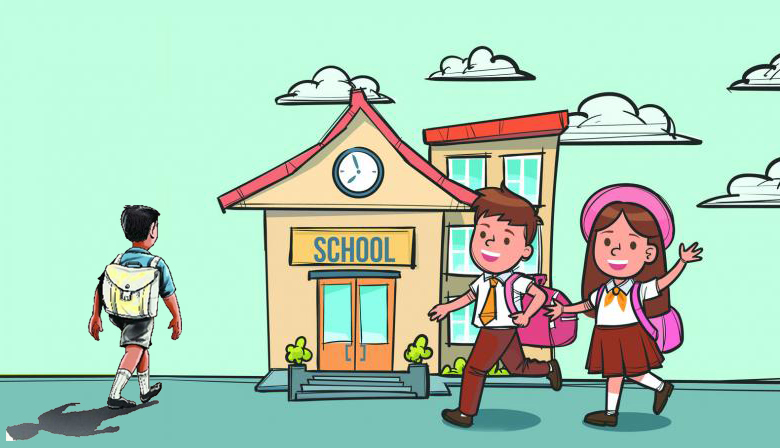
SDG: School dropout rate drops

With a target of achieving quality education and sustainable development goal (SDG) in education, the government has been able to reduce the dropout rate significantly in primary, secondary and higher secondary schools.
“The dropout rate has come down from 48 per cent to 18 percent in the last 10 years. The government has introduced special school feeding and scholarships programmes to prevent school dropouts,” said Education Minister Dr Dipu Moni at the seventh session of the SDG-Education 2030 as part of the 40th UNESCO General Conference at UNESCO headquarters in Paris on November 12th.
The Education Minister said, “The government has given great importance to achieve quality education as laid out in ‘SDG-4’ and Bangladesh has achieved significant success in this regard. At present, the enrollment rate in Bangladesh primary schools is 98 percent and the number of female students is higher than that of male students.”
Referring to Bangladesh’s commitment to achieve SDGs, Dr Dipu Moni said that Prime Minister Sheikh Hasina has appointed a senior bureaucrat to monitor the activities related to achieving SDGs.
Akram-al-Hossain, Secretary of Ministry of Primary and Mass Education told Bangladesh Post, “We are trying to ensure quality education and reduce dropout in public schools. We have emphasized on reading, writing and math olympiad for the primary school students.”
He said, “We have launched school meal programmes at different schools in remote areas. We have a target to introduce school feeding in all schools by 2023. This will greatly reduce the dropout rate.”
According to the Bangladesh Bureau of Educational Information and Statistics (BANBEIS), the dropout rate in primary was 17.9 percent in 2019, 18.6 percent in 2018, 18.85 percent in 2017, 19.2 percent in 2016, 20.4 percent in 2015 and 20.9 percent in 2015. But in 2009 the dropout rate was 45.1 percent.
Therefore, in last 10 years, the number of dropouts has reduced greatly as a result of various initiatives taken by the government.
The school dropout rate in secondary was 37.62 percent in 2018, 37. 81 percent in 2017, 38.30 percent in 2016, 40.29 percent in 2015 and 41.59 percent in 2014. But in 2009 the dropout rate in secondary stage was 55.31.
The school dropout rate in higher secondary was 19.63 percent in 2018, 19.89 percent in 2017, 20.08 percent in 2016, 20.7 percent in 2015 and 21.37 percent in 2014. In 2009, the dropout rate at this level was 42.11 percent.
Therefore, the dropout rate has reduced more than 22 percent over the last 10 years in primary, secondary and higher secondary schools.
With the aim of creating skilled human resources, targets have been set for the overall improvement of education, reducing discrimination in education, achieving quality, excellence, and expansion of education.
After a long waiting of nine years, a total of 2,730 non-government educational institutions across the country had been enlisted under the scheme of monthly payment order (MPO) in 2019.
As per the announcement, a total of 1,651 schools and colleges under the secondary and higher education division had been enlisted under MPO scheme. Of the total, 439 institutions are in the junior secondary slot covering grade 6 to grade 8, while 108 institutions are in the secondary slot from grade 6 to grade 10.
On the other hand, 887 institutions belong to the secondary slot of grade 9 and 10 while 68 institutions are under the higher secondary slot. There are 93 colleges covering eleventh and twelfth classes while 56 are degree colleges.
A total of 557 madrashas have been enlisted under the MPO scheme. Of those, 358 are dakhil madrashas, 128 are alim, 42 are fazil and the remaining 29 are kamil madrashas.
Besides, 522 technical institutions have also been enlisted under the scheme. Of those, 62 are agriculture-based institutions and 48 vocational (independent), 129 are affiliated as vocational institutions, 175 belong to business management (BM) category (independent institutions) and the remaining 108 are BM-affiliated institutions.
The last MPO announcement came in 2010 when a total of 1,624 educational institutions were given such facilities.
After a long waiting, the government selected a total of 18,147 candidates as primary school teachers this year. On December 24, 2019, the primary and mass education ministry published the list of the successful candidates. A total of 2.4 million people applied for the jobs. A total of 63,601 government primary schools across Bangladesh now have 322,766 teachers.
In a bid to ensure quality education at the primary level, the government has brought some remarkable changes in the process of forming managing committees of government primary schools across the country.
The Ministry of Primary and Mass Education finalized the policy in this regard by defi
Editor & Publisher: S. M. Mesbah Uddin
Published by the Editor from House-45,
Road-3, Section-12, Pallabi, Mirpur
Dhaka-1216, Bangladesh
Call: +01713180024 & 0167 538 3357
News & Commercial Office :
Phone: 096 9612 7234 & 096 1175 5298
e-mail: financialpostbd@gmail.com
HAC & Marketing (Advertisement)
Call: 01616 521 297
e-mail: tdfpad@gmail.com